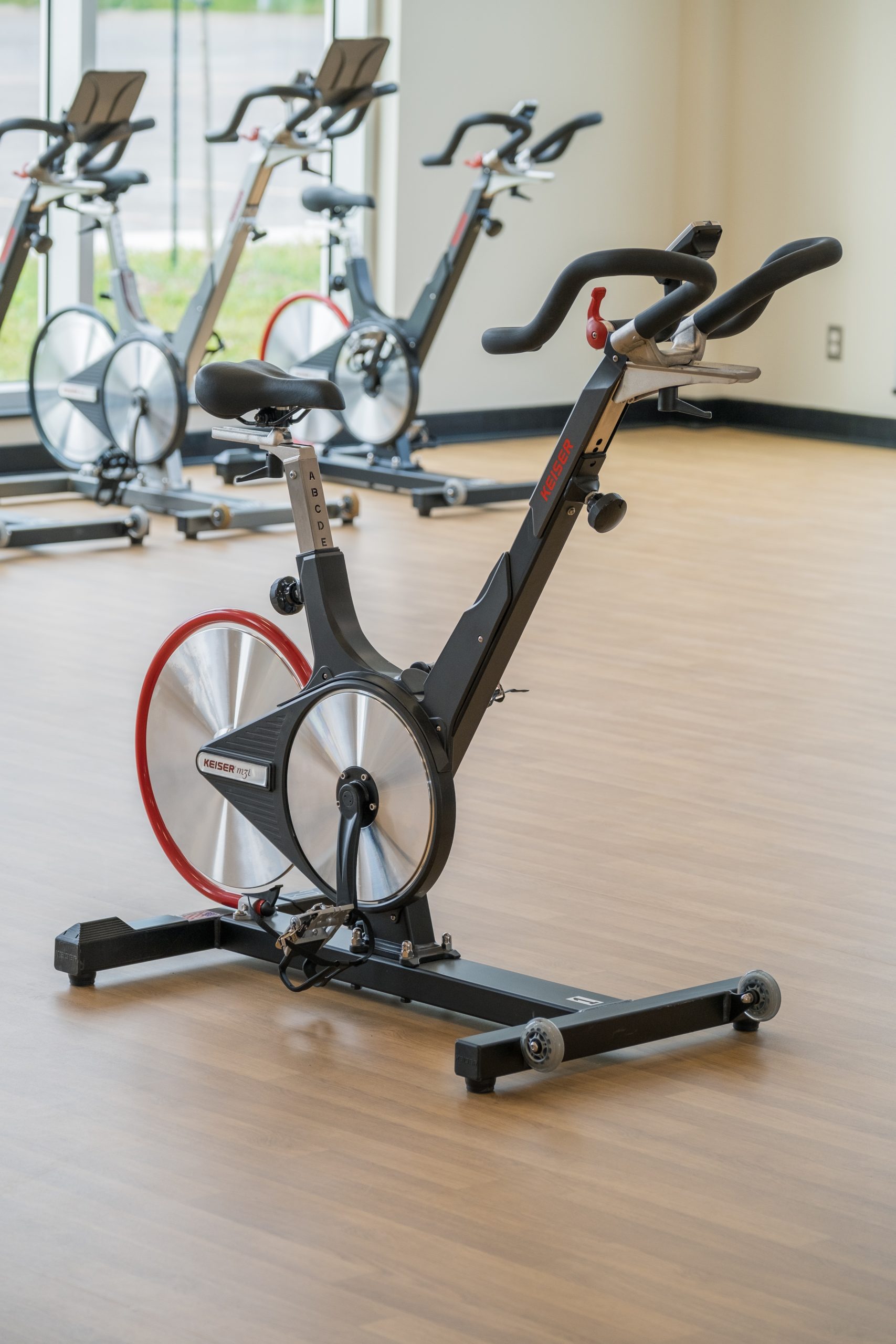Keiser vs Peloton – Everything you need to know
Have your caught on to the cycling at home craze yet? If so, the chances are you’ve heard of Peloton bikes. But did you know there are a number of other bikes on the market that are seemingly as good as the Peloton? If your researching Peloton alternatives, you’ve probably heard of the Keiser m3i spin bike.
Both the Peloton and Keiser m3i are top of the line stationary bikes with a price tag to match.
Read on to explore the differences between the Peloton vs Keiser m3i bikes as well as the pros and cons of each bike. Hopefully we’ll help make up your mind as to which bike is perfect for you.
Keiser m3i
Made in the USA, the Keiser m3i bike is a commercial grade, sturdy bike that you find in studios and gyms and is made to last. It has a reputation for being a quality bike and is backed with solid customer service. The company has been in business for over 20 years and they have worked hard to develop their bike to meet the needs of indoor cyclists.
Made to the highest quality control standards, the Keiser m3i comes with a whopping 10 year warranty on the frame. The Keiser does have its own workout app called The Ride but the high price of the bike is due to the actual quality of the bike. The Keiser is also somewhat unique in that it is designed to integrate with other fitness apps (including the Peloton app).
This Youtube video gives a great overview of the Keiser m3i
Peloton
Peloton aims to replicate at home, the experience you would get at a gym spin class. When you pay a monthly subscription fee, you get access to pre-recorded and live spin classes (as well as non-bike classes), through the touchscreen attached to the bike. Peloton is very good at keeping the rider motivated to keep using the bike. The touchscreen on the bike gives you a lot of stats about each of your rides and records these stats so you can see your progression over time. Through its leaderboard (electronic scoreboard) you can compete with others doing the same class.
After the success of the standard Peloton bike, a more expensive version of the bike was released called the Bike+.
However there are other stationary bikes out there that are just as good, if not better than the Peloton, that cost less. In fact the Peloton has been described as a $1300 bike with a $700 ipad stuck to it (that has the potential to become outdated pretty quickly). When you buy a Peloton bike, you are really paying for the software integration. You are also paying to feel like you are part of an exclusive club (the bike looks pretty impressive and there is plenty of branded Peloton clothing you can buy).
This Youtube video gives a great introduction to the standard Peloton bike and the Peloton Bike+
Major differences between the Keiser m3i and the Peloton
Visually, the main difference between the Keiser m3i and the Peloton are that:
- the Peloton has a large touchscreen for viewing the workouts and displaying and recording your metrics for each ride (the Peloton Bike+ touchscreen is even larger at 23.8-inches) . The Keiser m3i has a smaller, much less elaborate LCD screen (with no touchscreen functionality) to record your crucial metrics (power, cadence/RPM, power (output), kcals, heart rate (although it is not compatabile with all heart rate monitors), distance, and gear (resistance). It also has Bluetooth wireless technology to transmit your data from the Keiser to a different device. The mini screen allows you to snych your workout data with any device from various apps including the Peloton app. You will also need a device (such as ipad or TV) to stream your workouts from your app of choice.
- Peloton has excellent workout streaming options (including non-bike workouts), whereas Keiser has a limited workout app called The Ride.
- the flywheel (a weighted disc that spins, creating the resistance when you ride) is on the back of the bike with the Keiser m3i while the flywheel is on the front of the Peloton. The flywheel is much heavier on the Pelton (38lbs compared to 8 lbs on the Keiser). A heavier flywheel feels like you are riding a bike outdoors because it requires more power to start moving and takes longer to stop. The flywheel doesn’t have an impact on resistance however – that is determined by your resistance levels.
- The Keiser m3i has a mechanical resistance lever located at the front of the bike right next to the handle bars that you can move from 1 -24. The Peloton has a resistance knob that can move from 1 -100. The Peloton Bike+ also has the option of automatic resistance which means the resistance will automatically change in line with the workout you are doing.
- The Keiser bike has a unique V-shape frame design, allowing the seat and handlebars to be raised in conjunction with one another. This makes the bike suitable for riders with longer legs, torsos and arms.
- Both bikes have a holder for hand weights. The holder is at the front of the Keiser m3i and the back of the Peloton.
- Peloton has a dual water bottle holder while the Kesier m3i’s holder is single.
There are also a few other differences between the bikes:
- the handle bars on the standard Peloton cannot move forwards and backwards, they just raise and lower. Both the Peloton Bike+ and the Keiser m3i’s handlebars can move forwards and backwards. They can also raise and lower.
- the Keiser m3i has a 2 sided pedal meaning you can use normal gym shoes with the caged side and spd cycling shoes with the other side. Peloton requires cycling shoes.
- the Keiser’s LCD screen is battery powered (the batteries needs to be replaced annually). The Peloton needs a power outlet.
Pros of the Keiser m3i
√ Unlike the Peloton, no ongoing subscription is required to use the Keiser m3i. The bike is much more “open platform”. In fact the Keiser bike can be used with almost any platform (e.g. Zwift, Peloton’s digital app, Apple Fitness Plus, or no app at all). Also, while the Keiser m3i bike is compatible with the Peloton App, Keiser have also released their own app called The Ride which is significantly cheaper than Peloton’s app (although not nearly as good). At the time of writing this articles (March 2023), Keiser’s The Ride will set you back $6.99 USD per month, while the Peloton all access subscription will cost you $44 USD per month.
√ Keiser is a sturdy bike made to last. In fact the warranty of the frame of the bike is 10 years.
√ Keiser is a bit lighter than the Peloton and runs on a battery so there is no need to plug it. Unlike the Peloton it can taken outside or moved around easily.
√ Keiser has a great range of resistances and the maximum resistance on the Keiser is higher than the Peloton.
√ Normal gym shoes can be worn with the Keiser m3i or you can use the spd clip in pedals.
√ The Keiser m3i bike is suitable for riders with longer legs, torsos and arms due to the V-shape frame design (which allows for the seat and handlebars to be raised in conjunction with one another).
√ If you like your feet spaced widely apart when you are riding, you’ll like the Keiser m3i better than the Peloton. The Q factor (i.e. the distance between the left crank arm and the right crank arm) is 197 mm on the Keiser m3i. On the Peloton, the Q factor is 170m which is pretty narrow.
√ The flywheel is on the back of the bike with the Keiser m3i (it is on the front of the Peloton). So if you sweat a lot when you ride, the Keiser might be a better option because you won’t be dripping on the flywheel (and thereby subjecting it to corrosion).
√ The Keiser m3i uses magnetic resistance (as does the Peloton bike). Magnetic resistance is superior to friction resistance as it uses magnets to create a magnetic field, the strength of which determines resistance. Magnetic resistance is quieter and adjusting between levels is smoother. There is also less maintenance involved. Cheaper bikes ten to use friction resistance.
Cons of the Keiser
X The LCD screen provided with the Keiser m3i is not nearly as fancy as Peloton’s touchscreen.
X Keiser m3i does not include speakers or a camera (for interacting with other riders).
X Keiser m3i is not a “set and go” experience like the Peloton is. You will need to figure out a heart rate monitor, have a different device for streaming the workouts and invest in some data feed tools.
X Keiser m3i is more expensive than the standard Peloton bike but cheaper than Peloton’s Bike+.
X The Keiser m3i workout app called The Ride, is not nearly as good as the Peloton workout app.
X If you want to use the Peloton app with a Keiser m3i bike, it will be more difficult to work out the equivalent resistance levels the Peloton instructors are using. However you can use the Keiser resistance conversion chart to get an idea of what gears equal what Peloton resistance.
Pros of the Peloton
√ Peloton has a very fancy touchscreen which displays all your metrics.
√ Peloton comes equipped with speakers and a camera so you can interact with other riders.
√ Peloton is designed to be a “set and go” experience.
√ The subscription for the Peloton workouts gives you access to a huge amount of workouts (not just spin classes).
√ The Peloton Bike +, has Apple watch support.
√ On the Peloton Bike +, you have the option to set the Peloton to auto adjust the resistance during the rides to match the instructor’s resistance (you can also adjust the resistance manually if you want).
√ The Peloton all-access subscription gives you access to live classes and allows you to participate in the leaderboard (an electronic scoreboard) and the competitive/ social aspects of Peloton. The Peloton all-access subscription also has a gamification aspect which might keep you motivated to use the bike and make what is essentially a boring activity, pretty fun. Further, the all-access subscription gives you access to the addictive Lanebreak rides. Each Lanebreak ride turns a potential boring bike ride into a video game. We’ve talked more about the features of the Peloton app and Peloton all access subscription here.
√ The Peloton bike uses magnetic resistance (as does the Keiser m3i bike). Magnetic resistance is quieter and adjusting between levels is smoother. There is also less maintenance involved. Cheaper bikes ten to use friction resistance.
Cons of the Peloton
X You are locked into using the monthly, ongoing Peloton digital subscription with the Peloton and subject to possible price rises. You are locked into this subscription unless you are going to use the Peloton digital app or alternative app via another device (these other apps do not integrate with the touchscreen).
X The touchscreen, which is a major selling point of the Peloton, becomes pretty useless if you ever unsubscribe from the Peloton subscription.
X The touchscreen might need to be replaced after a couple of years.
X the bike is kind of a pain to move around, because it is a heavier bike and has the touchscreen. It also needs to be plugged into a power outlet.
X Peloton bike comes out of the box with a pedal that means you can’t wear normal gym shoes (you could change the pedal if you wanted too though).
X Like the Keiser m3i, the Peloton is an expensive, top of the line bike.
Peloton bike vs Keiser m3i bike at a glance
| Features | Keiser m3i | Peloton |
| Comes with a touchscreen? | No (has a mini screen which displays metrics) and a tablet tray to hold your own device | Yes |
| Location of the flywheel | Back | Front |
| Flywheel weight | 8 lbs | 38 lbs |
| Maximum weight of rider | 350 lb (159 kilos) | 297 lb (135 kilos) |
| Minimum height of rider | 4ft 9 | 4 ft 11 |
| Maximum height of rider | 7ft 3 | 6 ft 4 |
| Bike weight | 92lbs
| 140 lb (for the Peloton Plus) 135 lb for the standard Peloton) |
| Shoes | Normal workout shoes can be worn or cycling shoes using the SPD cleats | Can’t wear normal gym shoes unless you change out the pedals |
| Ongoing monthly subscription required to use the bike? | No | Yes |
| Integrates with other apps? | Yes | No |
| Resistance range | 1 -24 | 1-100 |
| Resistance mechanism | Mechanical | Mechanical + Digital on the Bike+. The Bike + also has the option of automatic resistance which means the resistance will automatically change in line with the workout you are doing. |
| Type of resistance | Magnetic | Magnetic |
| Cost | US $2460 | Starts at US $1,445 (Standard bike) Starts at US $2495 (Bike+)
|
| Q factor (the distance between the left crank arm and the right crank arm) | 197 mm | 170m |
| Handlebars
| Keiser handlebars can be move forwards and backwards. The handlebars can also raise and lower.
| Handlebars cannot move forwards and backwards, they just raise and lower on the standard bike.
The Peloton Bike+ has vertical and lateral handlebar adjustment |
| Power | Mini screen is battery powered (that needs to be replaced annually) | Runs on electricity |
| Warranty | 10 yrs on frame 3 yrs on cylinders, displays, displays, processor boxes, and thumb buttons 2 year on compressor and dryer, cables, pulleys and bearings
90 days on aesthetics (such as paint and upholstery) | 5 year on frame 1 Year on touchscreen 1 year on bike components and pedals 1 Year on labor |
| Comes with speakers? | No | Yes |
| Comes with a camera (so you can interact with other riders) | No | Yes |
So should you get a Peloton or a Keiser m3i bike?
Whether you should get a Peloton bike or a Keiser m3i ultimately comes down to personal preference. The Peloton is a decent, sturdy bike but the software integration is what makes Peloton special. If you are not going to use the software (by paying for a monthly subscription to access the Peloton classes), there is little point in paying for such an expensive bike.
If your okay with accessing the Peloton classes via your ipad, phone etc. or using another workout app altogether and not having access to the social/ competitive aspect of Peloton or the live rides, the Keiser m3i will give you a better, commercial grade bike.

Courtney has a passion for all things fitness on a budget. She loves home workouts and trying out different fitness gear.

